This week’s corn earworm (=bollworm) moth captures from local black light traps were: Sara Rutherford (Greensville ANR Agent) reported a nightly average of 13 moths; Scott Reiter (Prince George ANR Agent) had 16 per night at Templeton and 19 at Disputanta; and we averaged 28 in Suffolk. Here is the Table. In our pyrethroid resistance monitoring tests, the seasonal average is at 39% survival (n=278 moths tested).
Category Archives: Uncategorized
Be on the lookout for Sclerotinia blight in peanuts.
The system that brought rain on August 10th seems to have broken our streak of hot weather for Virginia’s peanut growing region. Dailey high’s in the 80s with lows in the 60s will continue until August 23rd according to my weather app. The temperature Saturday the 13th may not get above 80o F and the low may be in the upper 50s, which is very favorable for the development of Sclerotinia blight. I anticipate the risk of Sclerotinia blight to be high the next 2 weeks, so fungicide sprays may be warranted in fields with a history of that disease. If growers have sprayed the second spray of Miravis + Elatus fungicides within the past 2 weeks they should be covered. I do not recommend spraying the Miravis + Elatus fungicide tank-mix now if you haven’t sprayed it already due to fungicide resistance concerns with late leaf spot and the lack of curative or “kick back” activity if leaf spot already exists. If the Miravis + Elatus tank-mix has not been sprayed twice already I recommend using Omega 500 at the labeled rates for Sclerotinia blight sooner than later. Typically we recommend growers scout for Sclerotinia blight when the risk of that disease is high according to the Virginia Sclerotinia Blight Advisory. Omega 500 will have greater efficacy if applied prior to or at the initial onset of disease. Follow-up sprays may be made using Omega 500 21 days after the first application if favorable disease weather persists.
As always, if you have questions or concerns about diseases of agronomic crops please feel free to call or text me at (757) 870-8498 or e-mail me at dblangston@vt.edu.
Corn, Peanut and Soybean Disease Update
Corn
Virginia growers are over the hump so far as corn disease management is concerned. Late season diseases such as tar spot and southern corn rust have not been observed in Virginia at this time and we are past the R3 (milk) stage which is the cutoff for making effective fungicide applications for each disease. Click the link for updated maps showing where each disease is currently in the U.S. https://corn.ipmpipe.org/diseases/
Peanuts
As of August 1st, peanut growth and development is a little behind in areas that have experienced periods of severe drought. Heat units for peanuts planted on May 1st so far are on par with 2021, which was a record-breaking year so far as yield is concerned. Growers in Virginia have made at least one fungicide application for leaf spot by August 1st, and many have made 2 applications. The risk of Sclerotinia blight has been variable based on the differences in vine growth due to drought in certain areas, however, recent rainfall events have been more numerous in the region and I expect disease pressure will continue to increase. Increased rainfall and relative humidity will shorten the LESD (last effective spray date) for leaf spot for most fungicide chemistries and growers using Miravis should consider spraying at 21 days after the first application if disease risk for leaf spot is continually high since the last spray of that product. Growers that have already made applications of Miravis tank-mixed with Elatus will have some protection against Sclerotinia blight and growers that are opting for Omega 500 should be scouting fields with histories of that disease, especially in those fields where peanut canopies are dense, to make applications at disease onset. If Miravis or the Miravis/Elatus combo was not applied as the first or second fungicide application I do not recommend using it in August or later due to concerns with fungicide resistance and the lack of curative or “kick back” activity associated with those chemistries. If peanut leaf spot severity becomes high due to weather and the inability to get equipment in fields to make timely fungicide applications, rescue treatments using Microthiol Disperss or chlorothalonil tank-mixed with Group 3 fungicides, such as Provost Silver, to reduce defoliation prior to digging.
Soybean
Fungicides have recently been going out for foliar diseases recently as most soybeans are in the R1 – R5 growth stages. Recent weather patterns have brought and continue to bring rain events and high relative humidity which favor the development of frogeye leaf spot and other foliar diseases. My main concern for fungicide applications is to avoid using Group 11 (strobilurin) fungicide chemistries alone as fungicide resistance to those has been previously documented in the frogeye leaf spot pathogen in Virginia. There are plenty of Group 3 (triazoles), Group 7 (SDHI) and Group 11 fungicide combinations available to manage foliar soybean diseases. Also, I’m thinking of naming August as “SDS (sudden death syndrome) month” as that is when SDS usually starts showing up. The first clinic sample with SDS came in Tuesday on soybeans planted April 15th. Typically, SDS symptoms occur in early planted and early maturing soybeans first and continue as soybeans mature. Soybeans planted early in cool (at or below 60°F), moist soils are more at risk of infection by the pathogen that causes SDS, Fusarium virguliforme. The most visible symptoms occur at the late R5 growth stage and into R6. Managing this disease is strictly preventive through the use of crop rotation, delayed planting, resistant varieties and the fungicide seed treatments ILeVO and Saltro. We are gathering data on SDS outbreaks in Virginia so please contact us if you suspect this disease in your fields.
As always, feel free to contact me if you have questions regarding disease and nematode issues in your fields. e-mail: dblangston@vt.edu, cell: 757-870-8498
Squash vine borer is bad this year
In southwest Virginia we’ve seen a lot of squash vine borer problems this summer. More than usual. This moth pest lays its eggs (singly) at the base of squash or pumpkins, where the larva quickly bores into the plant after egg hatch and ultimately kills the vine or entire plant (as we’ve seen in our squash research plots in Whitethorne, VA).
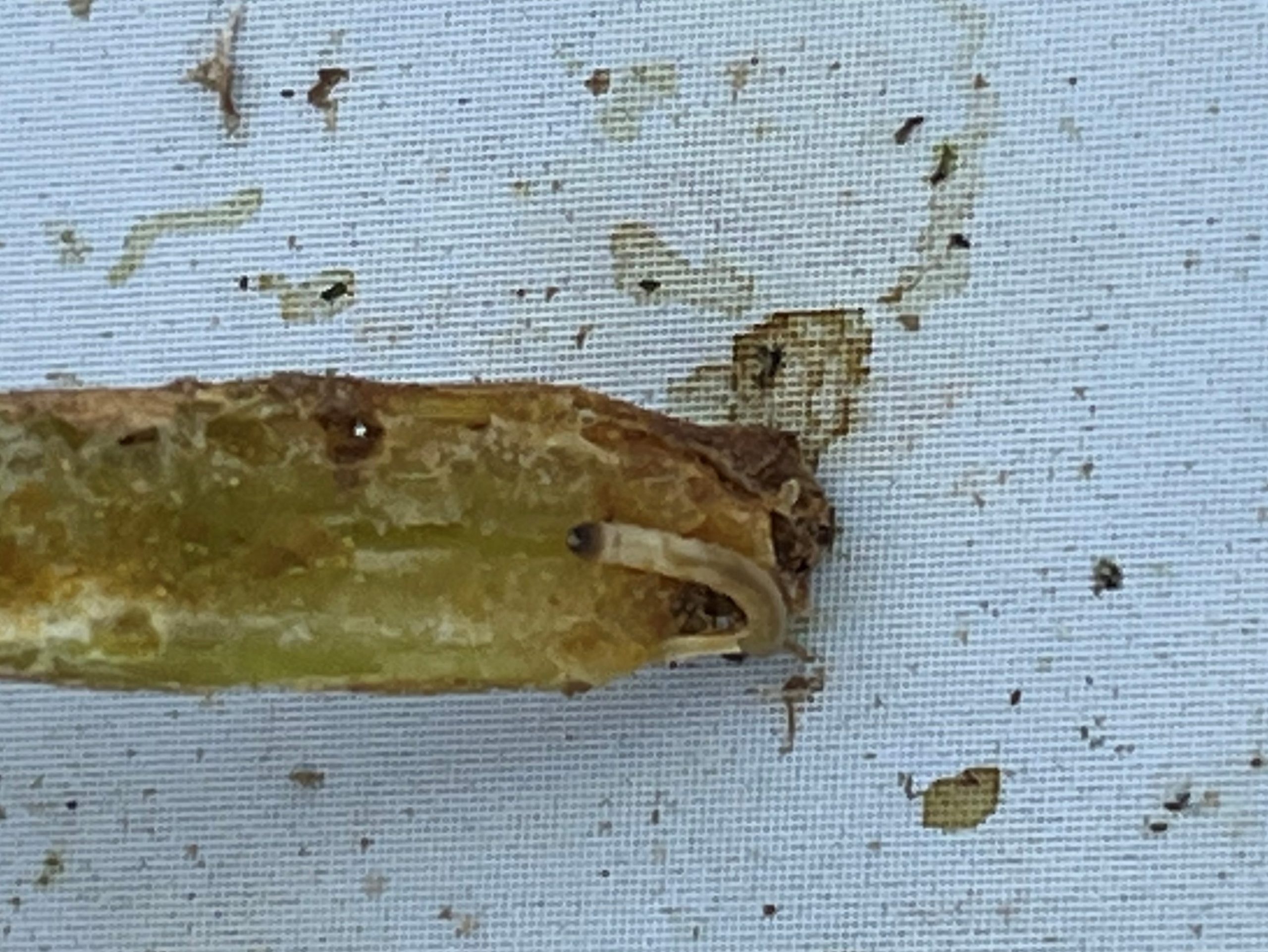
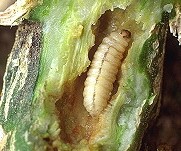

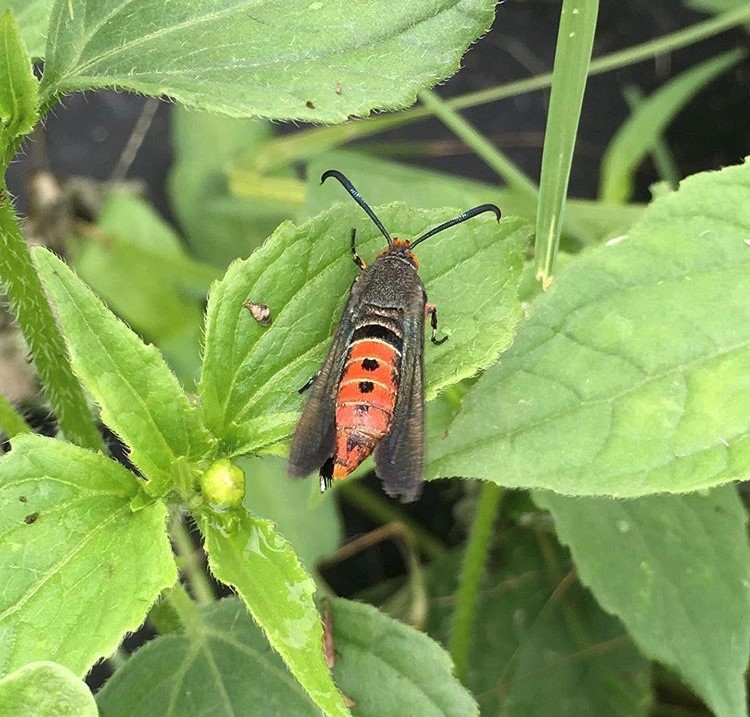
Control
Squash vine borer can be a major pest challenge for growers and home gardeners. If you only have a few plants to protect, then trying to cover the base of plants with aluminum foil or the cardboard can help as the moth prefers to deposit the egg at the base of plants. This acts as an oviposition deterrent. However, this is not practical for commercial growers and the best control option is an insecticide spray directed at the base of plants where the female moth may contact it and die before laying the egg, or, after egg hatch, the young neonate larvae may die from the insecticide residue before boring into the plant, where it will be protected. Pyrethroids such as Asana XL (esfenvalerate), Baythroid XL (beta-cyfluthrin), Brigade 2EC (bifenthrin), Danitol 2.4EC (fenpropathrin), Hero EW (zeta-cypermethrin + bifenthrin), Warrior II or Lambda-Cy 1EC (lambda-cyhalothrin), Mustang Maxx (zeta-cypermethrin), Permethrin 3.2EC, Tombstone (cyfluthrin), to name a few, are the most effective insecticides for quick contact control of the SVB. As always, please read the label before using any insecticide and be mindful that pyrethroids are toxic to pollinators and other beneficial arthropods. So avoiding spraying when flowers are open and in bloom, and directing sprays to the base of plants will help reduce nontarget impacts.

Virginia Ag Expo is Thursday, Aug 4
I want to remind everyone that the Virginia Ag Expo, Virginia’s largest field day, is next Thursday, Aug 4. The Expo is an educational, marketing, and social event that farmers and agribusiness look forward to each year. It moves from one location to another each year and strives to showcase the diversity of Virginia Agriculture. Our host this year is Mill Creek Farms and the event will be located at Camden Farm, which is located near Port Royal, right off of Highway 17 in Caroline County.
Precision for Profits is the theme for the 2022 Virginia Agricultural Expo. There will be a wide variety of agribusinesses present (currently over 85 exhibitors) showcasing the latest equipment, technology, goods, and services. Virginia Cooperative Extension will be working with NRCS to highlight the diversity of soils on this farm and the high potential for precision agriculture practices. Field plots are once again a walking, go-at-your-own-pace tour designed to fit your interest and schedule. Breakfast and Lunch will be catered by the vendors shown below.

The Virginia Ag Expo is jointly sponsored by the Virginia Grain Growers and Virginia Soybean Associations, in Cooperation with Virginia Cooperative Extension.
This event is FREE to the public. Click the link below to let us know you are coming!
When to start spraying peanuts for leaf spot and other diseases.
I have had a few questions about starting a peanut fungicide program on slow growing or late planted peanuts recently. The rule of thumb date I typically use is if you haven’t sprayed for leaf spot by July 10th, go ahead and start making applications by that date. I know many growers that may spray once or twice before July 10th or R3 (early pod), but this year may be a good year to start spraying later. My thought process here is that: 1) leaf spot fungicide applications made on young peanuts in the early, vegetative stages are less susceptible to leaf spot; 2) much of the fungicide applied ends up on the soil surface and can’t protect peanuts or be taken up by foliage; and 3) since it seems peanut growth is delayed digging may occur later than normal so fungicide applications may be needed later than normal. If you start spraying now you may increase the number of fungicide applications you end up making, driving up production costs. In fields on rotations of 3 years or less (higher risk of leaf spot), spraying earlier than July 10th may be warranted. The best way to reduce fungicide inputs is by using a spray advisory such as the Virginia Peanut Leaf Spot Advisory available on the Peanut-Cotton InfoNet (https://webipm.ento.vt.edu/cgi-bin/infonet1.cgi) or the Virginia Peanut Hotline at 1-800-795-0700.
Speaking of disease advisories, don’t forget the VSBA (Virginia Sclerotinia Blight Advisory). One thing to make note of with the VSBA is that much of the risk calculated for Sclerotinia blight is based on the vine growth and canopy development of peanuts. So if peanuts are behind in growth the risk of developing Sclerotinia blight is also delayed. Therefore fungicide applications made to prevent Sclerotinia blight should be made later depending on vine growth. I would at least wait until vines are less than 6-inches from meeting in row middles before making a fungicide application specifically for Sclerotinia blight. The Miravis + Elatus tank-mix targets both leaf spot and Sclerotinia blight, so the July 10th start date still applies to the first application of that combination. Keep in mind that if it looks like we may be digging peanuts late that an additional application of Omega 500 may be needed up to 30 days prior to harvest to manage Sclerotinia blight if the second Miravis + Elatus tank-mix is applied in early August. Also, I recommend a FRAC Group 3 or DMI fungicide (like Provost Silver) that’s effective against Sclerotinia blight to go out with the last application of Miravis in case some leaf spot is present at the time of application. FRAC Group 3 or DMI fungicides have some curative or “kick-back” activity which can arrest leaf spot that’s present at the time of application.
Be on the lookout for allium leafminer in your spring onions, garlic, or leeks
The allium leafminer (ALM), Phytomyza gymnostoma (Loew) (Diptera: Agromyzidae), is an invasive fly species that was first recorded in the U.S. in Pennsylvania in 2015. The pest attacks onions, garlic, and leeks where the larvae (maggots) feed on plant tissue by mining the plant causing wilting and possible death. This new pest to the mid-Atlantic area is a long grey-black fly with a distinctive yellow or orange patch on the top of its head, yellow sides and “knees” (femur-tibia junction), and white halteres (knobs as second pair of wings). The larvae are a typical whitish maggot. Adult females repeatedly puncture leaves with their ovipositor, resulting in a line of small white dots. Leaves can be wavy, curled and distorted. Larvae mine leaves and move into bulbs and leaf sheathes where they pupate. This invasive pest was recorded in southwest Virginia in 2021 and has been found in Montgomery, Carroll, Botetourt, and Bedford Counties in Virginia. Please pass this information on to VCE personnel and Master Gardeners so that we can track the spread of this invasive pest in The Commonwealth. The photos below show the life stages of this pest. The egg laying scars (perfect line of tiny circle marks on stems) are telltale sign.
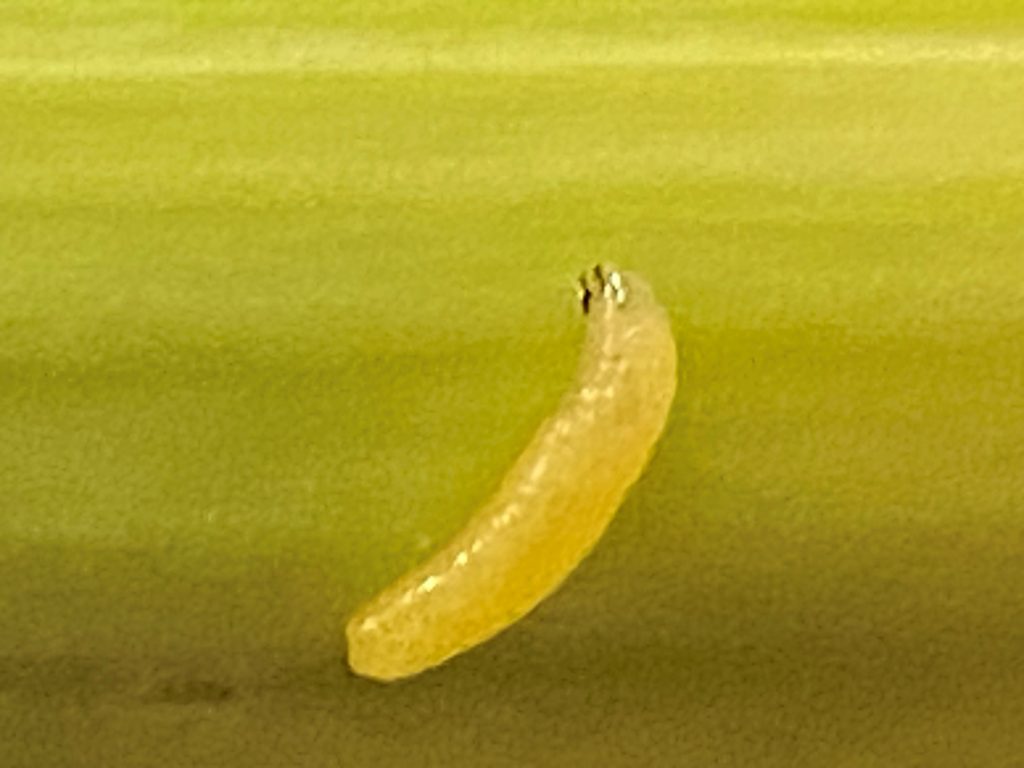

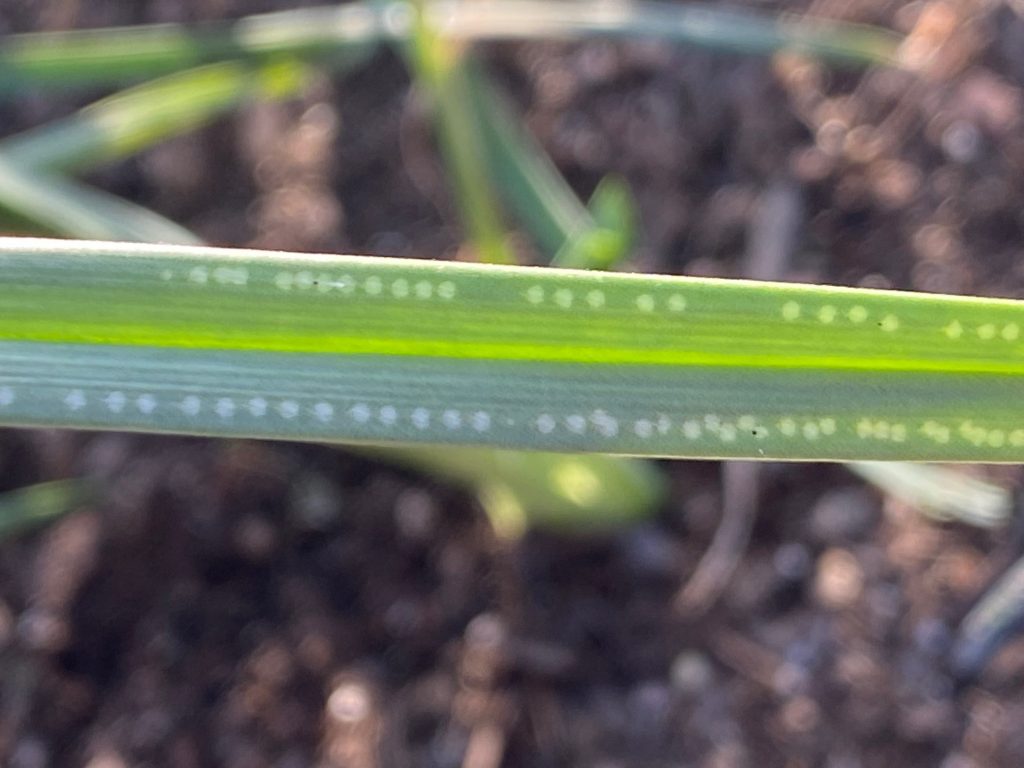
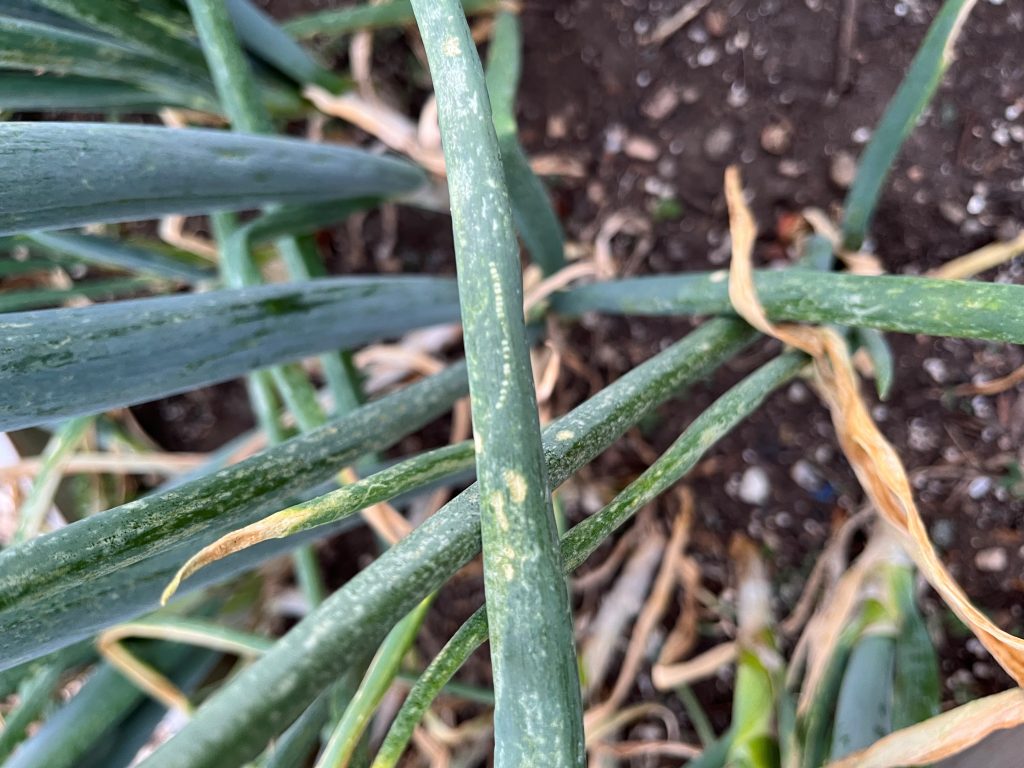
Control: Covering plants in April-May, or September-October, during the adult flights, can exclude the pest. A number of systemic and contact insecticides can provide effective control including neonicotinoids, diamides, spinosyns, and pyrethroids. Products registered for allium leafminer control include:
Mustang Maxx 2.88 to 4.0 fl oz/A zeta-cypermethrin
Warrior 1.28 to 1.92 fl oz/A lambda-cyhalothrin
Scorpion 35SL 8.75 to 10.5 fl oz/A dinotefuran – soil
Scorpion 35SL 5.25 to 7.0 fl oz/A dinotefuran – foliar
Venom 70SG 5.0 to 6.0 fl oz/A dinotefuran – soil
Venom 70SG 3.0 to 4.0 fl oz/A dinotefuran – foliar
Entrust SC (OMRI) 3.0 to 6.0 fl oz/A spinosad
Radiant SC 6.0 to 10.0 fl oz/A spinetoram
Trigard 75WSP 2.66 oz/A cyromazine
Exirel 13.5 to 20.5 fl oz/A cyantraniliprole
Minecto Pro 7.0 to 10.0 fl oz/A cyantraniliprole + abamectin
2022 Weed Management Field Day
Corn, Soybean, and Small Grains
June 14th, 2022
8:30 to 11:00am
Location: Southern Piedmont AREC. We will not be at the main station, but park directly in the field. Look for signs between Blackstone and the main station on Hwy 40/Darvills Road.
Google Maps link to field entrance: https://goo.gl/maps/iKZmYnjx7wM2
Field entrance near: 1200 Darvills Road, Blackstone, VA 23824. GPS is not always accurate. Field entrance between Nottoway Lanes and Military Road.
Continuing Education Credits Approved:
- NRCS Conservation Planner: 2.0
- DCR Conservation Planner: 2.0
- DCR Nutrient Mgmt Planner: 1.0
- Certified Crop Advisor: 2.0 (Pest Mgmt)
Please register by texting 540-315-2954 or emailing flessner@vt.edu
Highlights:
- View over 100 herbicide plots
- Learn about herbicide resistant Palmer amaranth and common ragweed control options
- Cover crops for weed control
- Harvest weed seed control:
- Chaff lining
- Redekop Seed Control Unit
- Pasture herbicide plots
If you are a person with a disability and desire any assistive devices, services or other accommodations to participate in this activity, please contact Michael Flessner at (540-315-2954) during business hours of 8:00 a.m. and 5:00 p.m. to discuss accommodations 5 days prior to the event. *TDD number is (800) 828-1120.
Virginia Cooperative Extension is a partnership of Virginia Tech, Virginia State University, the U.S. Department of Agriculture, and local governments. Its programs and employment are open to all, regardless of age, color, disability, gender, gender identity, gender expression, national origin, political affiliation, race, religion, sexual orientation, genetic information, military status, or any other basis protected by law.
Wheat Disease Update 4/27/2022
I have had reports of powdery mildew showing up in a few fields lately. Look for white, powdery spots on leaves in the lower canopy. The undersides of leaves can be covered in the powdery growth of the fungus. Cool, humid, dry conditions favor infection, while prolonged periods of cool, humid weather in spring can allow the disease to reach the flag leaf and cause yield losses. If you see powdery mildew in your wheat prior to heading a triazole, such as propiconazole (Tilt and generics) can do the trick, but the earlier the application the better. Fungicides applied at heading for wheat scab are also very effective against powdery mildew.
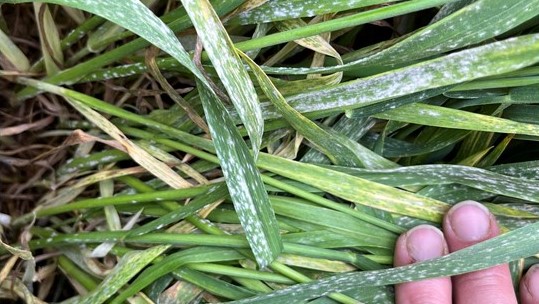
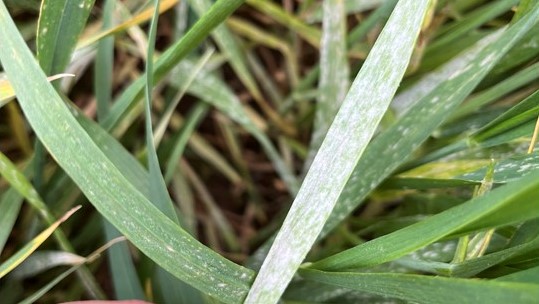
Wheat is heading and flowering across wheat growing regions in VA. The risk of wheat scab remains low due to dry, windy conditions. No fungicide application is warranted for scab management to crops that are currently flowering or will flower in the next several days. To assess risk of wheat scab, go to the web site https://www.wheatscab.psu.edu
Wheat Diseases – Diseases prior to heading and flowering.
It’s time to be scouting wheat for diseases and Virginia has had favorable conditions for disease development in wheat. There are really 2 times we should think about spraying wheat: 1) at Feekes Stage 9 (ligule visible on flag leaf); and 2) heading and early flowering (Feekes Stage 10.1 – 10.5). The spray at Feekes 9 is based on weather conditions and scouting while the Feekes 10.1 – 10.5 application is based on predicted disease risk and stage of flowering. Feekes 9 applications target powdery mildew, stripe rust, head and stem rust, Stagonospora leaf and glume botch, Septoria leaf blotch, and tan spot. The sprays at heading and flowering target wheat scab (Fusarium head blight). Most fungicides are efficacious against the diseases growers would spray for at Feekes 9 but only certain fungicides are recommended for sprays at heading and flowering as they have been shown to reduce the mycotoxin DON that the wheat scab pathogen produces. Also, strobilurins or FRAC Group 11 fungicides are not recommended for sprays at heading/flowering as these fungicides can actually increase DON levels. Fungicides recommended for DON are in the table below.
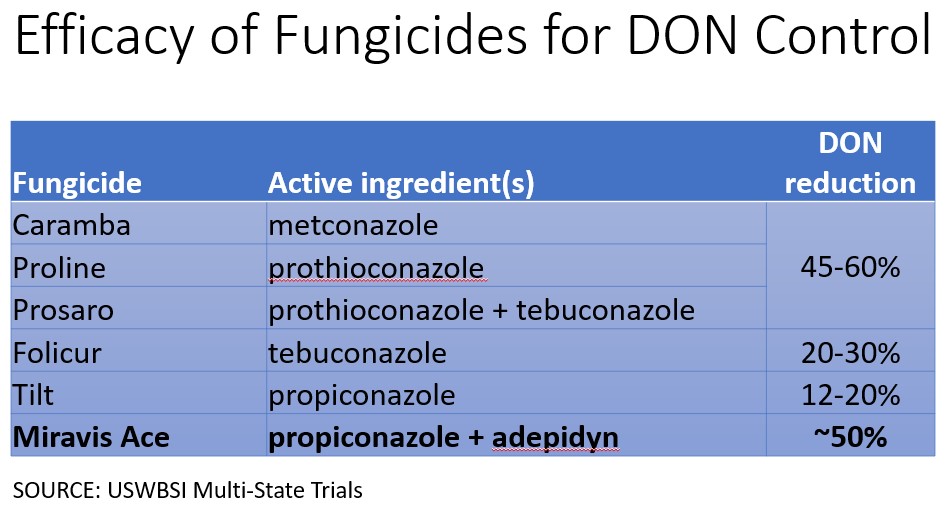
Fungicide efficacy for wheat diseases can be found in the Fungicide Efficacy Table produced by the Crop Protection Network at the following link: https://cropprotectionnetwork.s3.amazonaws.com/fungicide-efficacy-for-control-of-wheat-diseases-filename-2021-04-21-154024.pdf
Scouting for Wheat Diseases:
Begin scouting for wheat diseases around flag leaf emergence (Feekes 8) through Feekes 9 which is when the ligule of the flag leaf is visible. Be sure to look in different areas of the field, especially where wheat appears further along.
Pictures and descriptions of early wheat diseases are below.
Septoria tritici blotch: Look for elliptical or diamond-shaped, tan-brown lesions that often have yellowish halos. As lesions enlarge the center of the lesion dies and appears dark with small, dark specks which are fruiting bodies that give the lesion a characteristic speckled appearance. Subsequent lesions on higher leaves generally follow leaf veins, having straight edges and no yellow margin or halo. The dark lesion center and dark speckling is the key to distinguishing Septoria blotch from tan spot or Stagonospora leaf and glume blotch.
Symptoms of Septoria tritici blotch
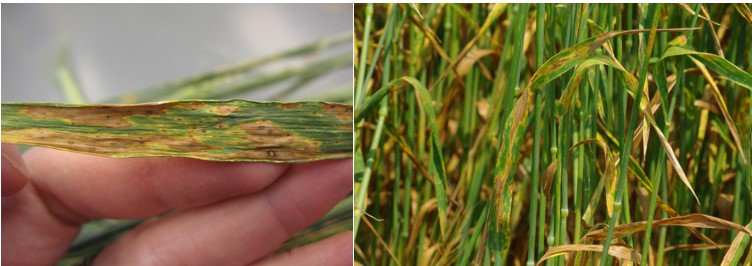
Left is a picture of Septoria blotch showing lesions with dark centers and little to no yellow halo except for new lesions. The right picture illustrates symptoms of larger lesions that have grown together.
Tan spot: Tan spot causes light brown or tan lesion with a light tan center that have a distinctive yellow halo (unlike Septoria that has a dark lesion center). Tan spot lesions are more oval than those of Septoria tritici blotch, but are more angular than Stagonospora leaf blotch lesions.
Symptoms of tan spot
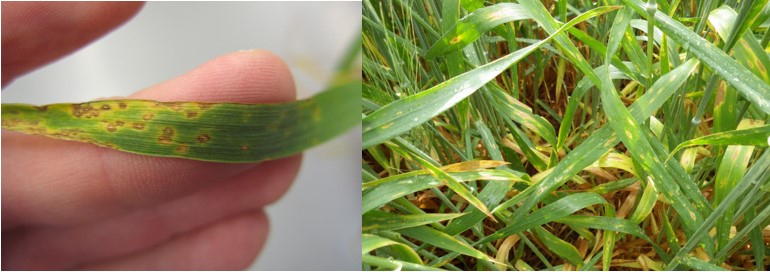
Left is a picture of tan spot lesions that are fairly oval and have tan centers. The right picture demonstrates the characteristic yellow halo caused by tan spot.
Stagonospora leaf and glume blotch: Foliar symptoms generally begin with small yellow flecks or spots. Spots grow to become lens-shaped lesions that are surrounded by yellow halos. Lesions are typically longer than those of tan spot but have a dark center like those of Septoria tritici blotch. However, a yellow halo is often present with Stagonospora and absent with Septoria. Symptoms on glumes appear as purple blotches or streaks.
Stagonospora leaf blotch symptoms
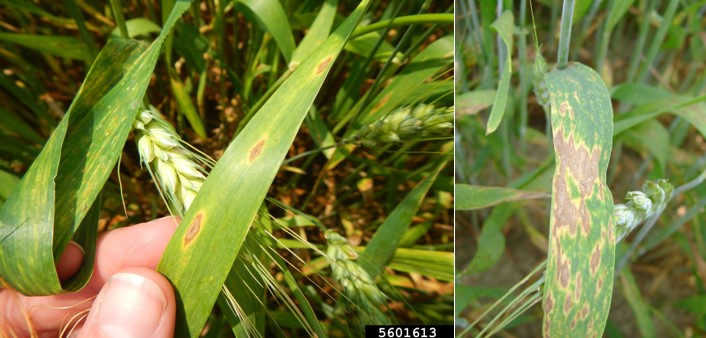
Left are early lesions while the right picture are coalesced lesions in more advanced infections. A distinct yellow halo is almost always present with Stagonospora.
Powdery mildew: Powdery mildew produces powdery, often fluffy fungal growth on stem and leaf surfaces. Leaf tissue can turn yellow under the powdery fungal growth. Signs of this disease typically appear on the lower leaves and work their way up the canopy. In advanced infections, little black dots can be seen in the fungal growth.
Signs of powdery mildew
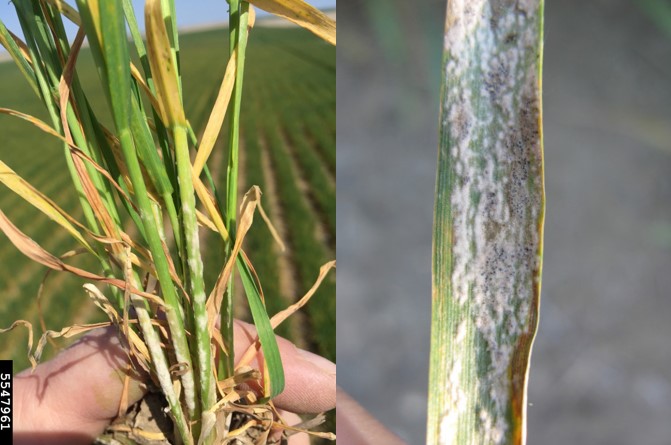
Left is fluffy fungal growth of powdery mildew on lower stems and leaves. On the right can be seen small, black fruiting bodies in the fungal growth.
Stripe rust: Although stripe rust doesn’t appear every year, when it does appear it can cause losses very rapidly. For that reason, you need to contact your local county agent or myself if you suspect stripe rust so we can quickly recommend control measures and alert other growers in the area of occurrence. Like most foliar diseases, strip rust starts out as yellowish flecks on leaves. From lesions appear yellow-orange, rust-like pustules on susceptible varieties. Pustules on mature leaves occur in parallel lines along the length of the leaf which appears as stripes.
Stripe rust symptoms and signs
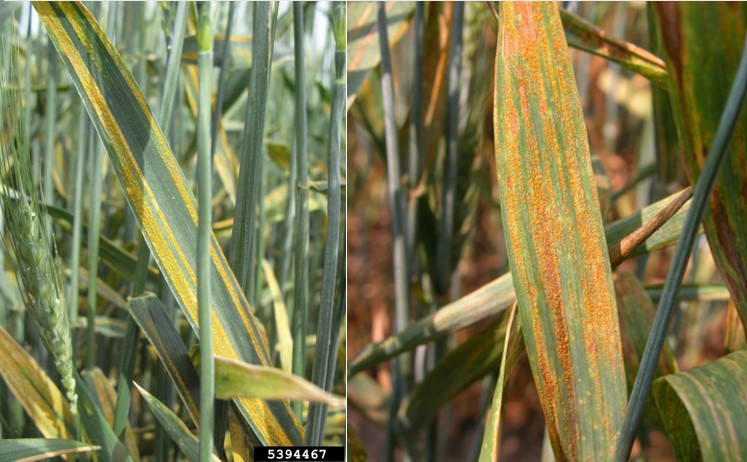
Very linear sporulation and symptoms of stripe rust on left. Larger, coalesced lesions of stripe rust on right.
Most products in the aforementioned efficacy table are effective against these foliar diseases if applied just before or soon after symptoms appear.
